Quality of life in patients with Crohn’s disease in the Czech Republic
Ján Bielik1, Anna Němcová1, Vladimír Meluš1, Katarína Gerlichová1, Pavel Svoboda2,3
+ Affiliation
Goal
The main goal of our work was to assess the quality of life (QoL) and work ability (WA) of patients with Crohn’s disease (CD) using the patients’ questionnaires. The assessment of both parameters was realized predominantly by applying the numeric scale that is considered appropriate for this type of disease, affecting both physical and mental health of patients. The additional goal was to assess the impact of selected parameters on QoL and WA (ability to take care of oneself in basic life and work activities) as well as evaluation of economic consequences of the disease on life of patients.
Samples and methods
The group consisted of 150 patients with Crohn’s disease with an average age of 38.5 years, of which 76 were men and 74 women with the average age of 36.71 in men and 40.36 years in women. The research was carried out from April to November 2016 at the gastroenterological outpatient clinic of the Faculty Hospital Ostrava, at the adult medicine department of the Faculty Hospital Brno, and at the gastroenterological outpatient clinic of the Hospital in Frýdek-Místek. Of the 160 patients contacted, 155 patients completed the questionnaire. Five questionnaires were discarded due to incomplete data.
The original questionnaire developed at the Faculty of Health of the Alexander Dubček University in Trenčín (FZ TnUAD) and used in the research of QoL and health economics, was used for data collection. Some parts of the questionnaire were specially adapted for the Crohn’s disease.
Descriptive statistics parameters – minimum, maximum, mean, median and standard deviation, and methods of analytical statistics – Friedman test, Pearson chi-square test, Kruskal-Wallis test, Mann-Whitney test and Spearman correlation coefficient were used in the statistical evaluation of results. If the P-value of the test criterion was equal to or lower than 0.05, the differences found between the tested variables were considered statistically significant.
Results
Quality of life and work ability
We evaluated QoL and WA based on the patients by numeric scale ranging from 1 to 10 (the worst – 1, the best – 10). Patients evaluated QoL and WA at the current time (assuming the full effect of treatment), but also retrospectively, i.e. at the time of diagnosis of the disease, at the time before the onset of the disease and at the time of the so-called full health. The QoL results are shown in Tab. 1 and 1a and the WA results are shown in Tab. 2 and 2a.
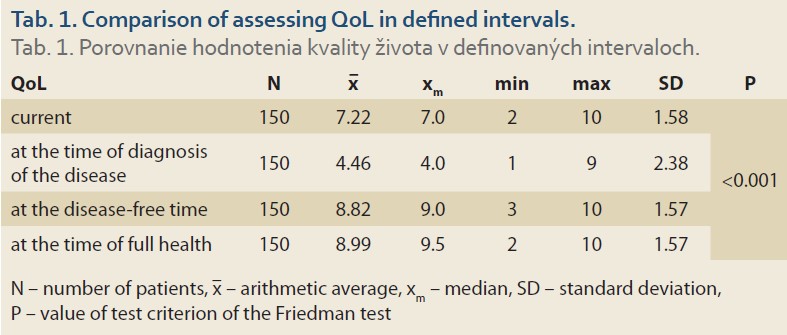
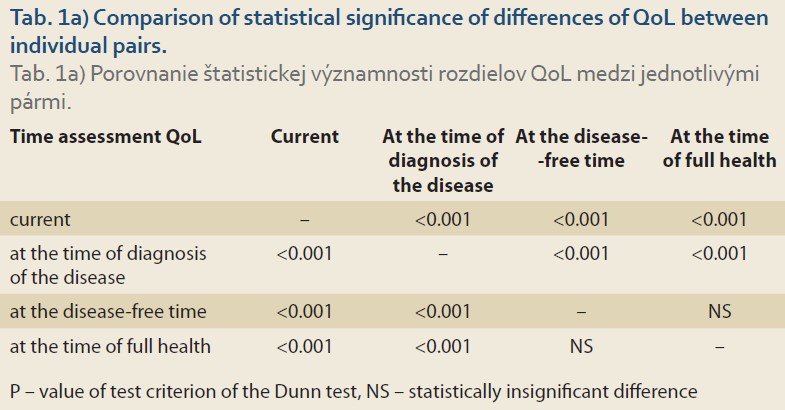
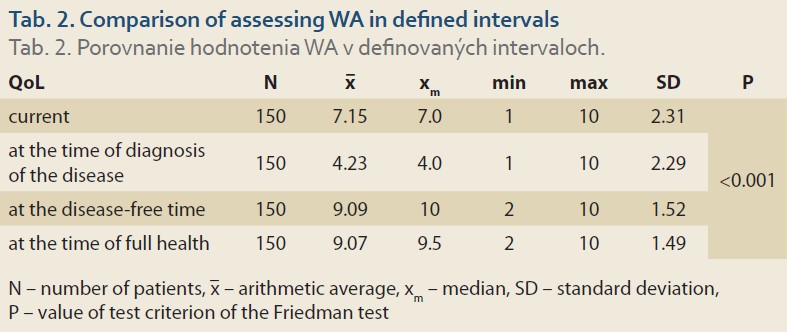
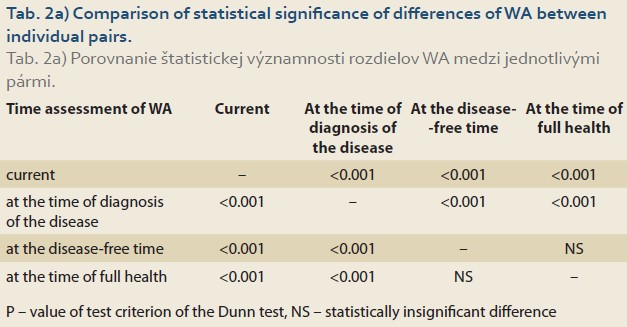
Mean values for QoL and WA did not differ significantly from disease status. QoL and WA at present (during treatment) reached 7.22 and 7.15 respectively, at the time of diagnosis it was 4.46 and 4.23 respectively, at disease-free time it was 8.82 and 9.09 respectively, and at the time of complete health it was 8.99 and 9.07 respectively.
Social and socioeconomic consequences
The average monthly direct and indirect costs amounted to €28.20, with the highest represented costs for drugs and transport. Patients experienced a deterioration in social life and social relationships (not at all – 1, very significantly – 5), while the smallest deterioration was observed in the family – 1.78, more in social life – 2.11, in employment – 2.47 and mostly in the leisure time activities – 2.8.
Social status
In terms of social status, 86 patients were employed and 15 patients were unemployed. Seven patients received a retirement pension, 38 patients received a full disability pension, 36 patients out of them due to CD and 2 patients due to other diseases. 4 patients received a partial disability pension (all due to CD). The average number of sick-leave days in the last year due to CD was 28.74 days, while in the case of sick-leave due to another reason it was 15.81 days. The average financial amount that respondents would be willing to sacrifice once for a complete cure was €18,903.67, while the willingness to pay for a complete cure on a monthly basis amounted to €70.40. The average value of net monthly income was €615.10.
Other correlations
When evaluated by the Friedman test, the following differences in QoL and WA were found at the level of statistical significance P <0.05: QoL as well as WA were significantly worse at the time of disease diagnosis compared to: disease-free state – full health and current condition (on treatment), as well as at the time of current condition versus disease-free and full health status. QoL as well as WA at the disease-free time and QoL at full health did not differ significantly. This finding essentially excludes the possible influence of other diseases.
No patient was found to have a QoL difference in their current QoL between men and women with Crohn’s disease (P = 0.21), but there was a statistically significant difference between them in the current WA, in which women had a mean and a median lower compared to men (P = 0.02, Mann-Whitney test).
Localization did not have a statistically significant effect on QoL (P = 0.40). However, localization in the colon had a statistically significant effect on WA (P = 0.02): this result was, due to a higher colons’ values, compared to colon + small intestine (P <0.05). There was no statistically significant difference between the other groups (Kruskal-Wallis test).
Different forms (transmural: stenotizing, fistulating) of Crohn’s disease did not have a statistically significant effect on current QoL and WA. Duration of the disease in years only had a significant effect on QoL (P = 0.007), while duration of the disease did not have an obvious effect on WA (P = 0.17, Mann-Whitney test).
Duration of symptoms before fixing the diagnosis (in years) had a marginal effect on QoL (P = 0.06), while this factor did not have a significant effect on WA (P = 0.007, Mann-Whitney test).
The intestinal impairment, compared to the extraintestinal impairment, had a significant effect on QoL (P = 0.05). while in the case of WA no significant difference was documented (P = 0.34, Mann-Whitney test).
Surgery for intestinal CD complication (fistula, stenosis) had a significant effect on QoL (P = 0.03). while in the case of WA no significant difference was documented (P = 0.10, Mann-Whitney test).
The results of correlation of the examined parameters and their impact on the actual QoL applying the Spearman correlation coefficient are shown in Tab. 3.
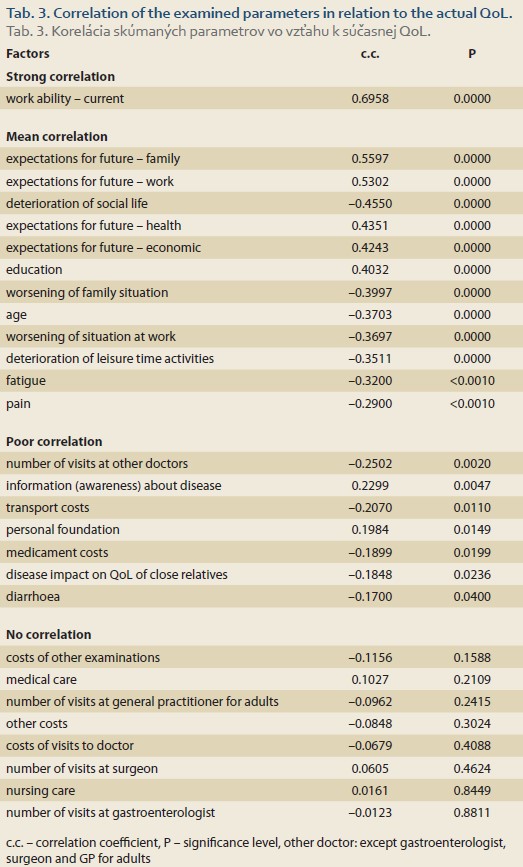
Fatigue, pain and diarrhoea, as the most important symptoms of CD, were correlated also in relation to WA: in the case of fatigue and pain, the same i.e. moderate correlation was found in relation to WA: –0.38 (P <0.001) resp. –0.44 (P <0.001), while in the case of diarrhoea, no correlation was found in relation to WA: –0.16 (P = 0.06).
Discussion
The questionnaire developed at our faculty is predominantly based on the patient’s evaluation of the relevant parameters using a numerical scale. The numeric rating scale was mentioned as valid, reliable, and responsive measure that may be useful to evaluate patients with CD [1] as well as to assess the QoL of patients with this disease [2]. Our study is therefore a study conducted, using the method “Patient-reported results” (PRO-s). At least for the last decade, this method has been considered useful and credible in evaluating treatment outcomes [3]. We used this method in many other studies with valuable outcomes [4]. Crohn’s disease as such has a negative impact on QoL [5], and it is precisely the symptoms which can have substantial psychosocial implications and cause sufferers to limit their lifestyles, with consequent impact on QoL. The most important of these are: diarrhoea, cramps (pain), fatigue and weight loss [6]. In our work, a significant effect of surgical intervention on QoL was confirmed, but in the case of the effect on WA, it was not confirmed. Older patients had a moderately negative correlation with QoL. An interesting finding in our study was that while intestinal involvement had a significant impact on QoL, extraintestinal complications did not have a significant effect on QoL, although a tendency to decrease arithmetic means and medians with increasing number of extraintestinal complications was documented. Intestinal involvement had no significant effect on WA, compared to extraintestinal involvement. Fatigue had a moderately negative correlation to QoL. Disease duration in years had a significant effect only on QoL, while WA was not apparently affected (P = 0.17). The representativeness of our cohort can be assessed by comparing with a study from the Czech Republic, which included 1,228 patients with IBD, out of whom 798 (65%) had CD. The most common symptoms reported by patients with IBD were: fatigue, weakness and exhaustion (66.4% of patients), followed by diarrhoea (61.6%) and abdominal pain (51.7%) [7]. In our study, 102 patients (68%) reported diarrhoea, 91 (60.7%) patients had abdominal pain, and 130 (86.7%) patients experienced some degree of fatigue. The described characteristics of our study did not significantly differ from the mentioned Czech study and we could consider our cohort as sufficiently representative. A good physicians-patient relationship in our study is evidenced by the level of awareness that patients rated at 4.32, medical care at 4.61, and nursing care at 4.41 (maximum 5). Our work was not primarily focused on studying the cost of CD, but we investigated the willingness to pay (WP). The average amount of money that respondents would be willing to sacrifice once for a complete cure was €18,903.67, while the willingness to pay for a complete cure on a monthly basis was expressed in the amount of €70.40. The average net monthly income was at the time €615.10. Although controlling the disease activity is of prime importance in patients’ well‐being, a holistic and multidisciplinary approach to care is required. To achieve this, health care professionals should aim to incorporate basic QoL assessment into patient consultations as well as focusing on this issue as an outcome measure in clinical trials [8].
Conclusions
In summary of our results, we state that the disease had a significant negative effect on QoL and WA. QoL strongly correlates with the current ability to work. Gender, location, and form did not affect QoL. However, women had significantly lower actual (current) WA. The localization of the disease in the colon was significant for a reduced WA. The duration of the disease had a significant effect only on QoL. The duration of symptoms before fixing diagnosis had a marginal effect only on QoL (P = 0.06). Intestinal involvement as well as surgery have a significant effect only on QoL, too. The treatment improves both QoL and WA. QoL showed a moderately strong correlation with fatigue and pain; family, work, health, and economic expectations for the future, as well as with deterioration in social life, and deteriorating family, employment, and deteriorating leisure conditions. Higher education showed a positive correlation with QoL, while older age showed a negative correlation. The disease significantly affects the rate of incapacity for work (sick leave) compared to other comorbidities. The number of diarrhea, the number of visits to another doctor, awareness about the disease, transport costs, drug costs, personality foundation, and the impact of the disease on the QoL of close relatives, show a weak correlation. No correlation was observed in the following factors: costs of other examinations, medical and nursing care, number of visits to the general practitioner for adults, costs of other expenses, costs of visits to the doctor, number of visits to the surgeon or gastroenterologist.
Assoc. Prof. Ján Bielik, MD, PhD.
Faculty of Healthcare
Alexander Dubček University of Trenčín
Študentská 2
911 50 Trenčín
jan.bielik@tnuni.sk
To read this article in full, please register for free on this website.
Benefits for subscribers
Benefits for logged users
Literature
1. Surti B, Spiegel B, Ippoliti A et.al. Assessing Health Status in Inflammatory Bowel Disease using a Novel Single-Item Numeric Rating Scale. Dig Dis Sci 2013; 58(5): 1313–1321. doi: 10.1007/s10620-012-2500-1.
2. Guassora AD, Kruuse C, Thomsen OO et al. Quality of life study in a regional group of patients with Crohn disease. A structured interview study. Scand J Gastroenterol 2000; 35(10): 1068–1074. doi: 10.1080/003655200451199.
3. Deshpande PR, Rajan S, Sudeepthi BL et al. Patient-reported outcomes: A new era in clinical research. Perspect Clin Res 2011; 2(4): 137–144. doi: 10.4103/2229-3485.86879.
4. Bielik J. Quality of life related to health and potential of implementation patient’s studies results oriented on quality of life in national drug policy. Zdravotnícke Listy 2017; 3(5): 38–41.
5. Blondel-Kucharski F, Chircop C, Marquis P et al. Health-related quality of life in Crohn‘s disease: a prospective longitudinal study in 231 patients. Am J Gastroenterol 2001; 96(10): 2915–2920. doi: 10.1111/j.1572-0241.2001.4681_b.x.
6. Ghosh S, Mitchell R. Impact of inflammatory bowel disease on quality of life: Results of the European Federation of Crohn‘s and Ulcerative Colitis Associations (EFCCA) patient survey. J Crohns Colitis 2007; 1(1): 10–20. doi: 10.1016/ j.crohns.2007.06.005.
7. Ďuricová D, Pfeiferová M, Bortlík M et al. Quality of life in patients with inflmmatory bowel diseases in Czech Republic – multicentric study. Gastroent Hepatol 2018; 72(1): 11–19. doi: 10.14735/amgh201811.
8. Sainsbury A, Heatley RV. Review article: psychosocial factors in the quality of life of patients with inflammatory bowel disease. Aliment Pharmacol Ther 2005; 21(5): 499–508. doi: 10.1111/j.1365-2036.2005.02380.x.